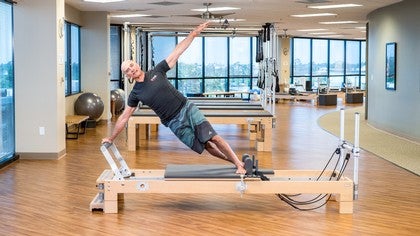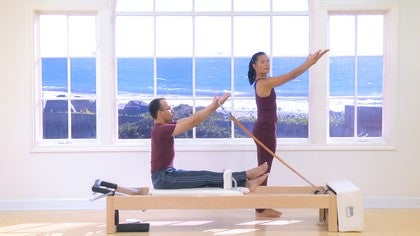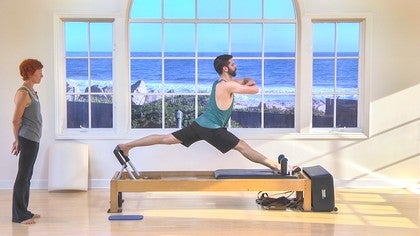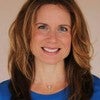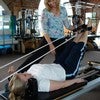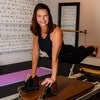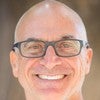Description
About This Video
Transcript
Read Full Transcript
Welcome to BASI Pilates Academy, fully furnished with BASI Systems equipment. Today, I'm going to be using a BASI Systems reformer, and it has some unique features. However, I choreographed this routine so that it can be performed on any reformer. I will add that I decided not to use a box in this routine. It is a flowing routine.
It's the kind of workout that I will do. I do several workouts a week, and this would be a typical workout, feel good on my own body. I hope it feels just as good on yours. I follow the BASI Block System. The BASI Block System is a structure for a workout, and I follow that structure, whether it's a short workout, a long workout, whether it's using apparatus or not.
This gives me a structure for creativity. Let's start with a few roll downs, setting your alignment for the session, and I will say, just before I begin, I've got one spring on the reformer, so it's light for this first beginning. (inhales) Inhale. (exhales) Exhale. This is as much for the mind as it is for the body, letting go of the outside world, being present in the moment.
Give that gift to yourselves. This is meditation in motion. (inhales and exhales) (inhales) Exhale as you roll down. (exhales) (inhales and exhales) I'm thinking of the alignment of the body as well as the muscle groups holding the body at every stage, so avoid the scapula elevating or falling forward here. I'm still using the stabilizers of the scapula.
The palms are facing each other, and as I articulate through the spine, my arms end up at the side of the body. Inhale (inhales) and exhale. (exhales) Inhale (inhales) and exhale. (exhales) Make sure that your feet are well-planted on the floor. Inhale, and this time I place my hands on the bar in this round position. I then flatten the back and give myself a stretch. There's very little pull on the reformer.
It's there for balance. I'm using my legs. I'm using my back extensors, and then (exhales) pulling up into that rounded position like a pike, and then I extend, inhaling and exhale (exhales) and inhale. (exhales) As you're down in the squat, think of your glutes. Think of the hamstrings, and the strong back, and exhale as you give your backs a nice stretch.
Step forward, closer to the reformer, and roll up. Inhale, and exhale as you roll down you place the heel of the hand on the carriage, keeping the weight over the legs as you, again, inhale to stretch the back out, and exhale as you pull back into that pike, and two, (inhales and exhales) and three. I love the interaction between the extensors of the trunk and the flexors. (inhales and exhales) One last one, (inhales and exhales) and slowly complete the exercise by rolling up. At this point, put the springs on that you use for your foot work.
I tend to work quite heavy, so I put all the springs on for my foot work. As long as you can hold good alignment, there's nothing wrong with working with a good, strong resistance. Easing yourselves onto the reformer, and place the heels on the bar, legs in a parallel position, we inhale, and we go into a pelvic curl, (exhales) and we inhale (inhales and exhales). We sometimes do this on the balls of the foot. Today, I'm electing to do it on the hamstrings, on the heels, I'm sorry, on the heels, to engage the hamstrings to a maximum.
It will also be the first foot position we use for the foot work, exhaling all the way down, and inhale (inhales), and exhale (exhales), and inhale (inhales). Notice I keep dorsiflexion here, and as I roll down, the feet stay in the same position. They don't move in and out. They stay very still, so it's maximum dorsiflexion when you're in the up position, and inhale, and slowly exhale as you come down. Glide the arms around, and hold onto the handles.
If you don't have handles, holding onto the shoulder rests is perfect. Lifting one leg and the other, bring your legs toward me for the spine twist supine (exhales) and away from me, (exhales) (inhaling and exhaling) and this is number six, and we do two more to each side, keeping those legs together. The movement is coming from the pelvis, through the spine. Last two inhale, and exhale, and inhale, and exhale. Bringing your hands to your knees and lifting up for a double leg stretch.
I love the double leg stretch here. It gives me an indication of where my legs should be, and my arms touch the shoulder rests, so that's a good indicator of the height of the legs and the reaching back of the arms, and inhale, and exhale, and inhale, and exhale, and inhale, and exhale, and inhale, and exhale, and inhale, and exhale, and inhale, and exhale, lifting nice and high, and slowly lowering down, just to release any tension in the neck. We're now going to do single leg stretches, so you lift up again into the position. Put your hands on the leg closest to me, and you exhale again here. We've got that gauge of the bar on the back of the leg.
Inhale to change, exhale, inhale (inhales), and four, and five, and six, and seven, and eight, leg goes out, straight out, nine, and hands behind the head for the crisscross, you rotate towards me, and one, and two, and three, and four, and five, and six, and seven, and eight, and nine, and 10. Bring the legs in, and go back to that pelvic curl position, so you're lifting nice and high here, back to the pelvic curl position, heels on the bar, and slowly put the body down for the foot work, and exhale, and inhale, and exhale (exhales), inhale, and three, we're gonna do an abbreviated foot work, and four (exhales), maximum dorsiflexion when the knees are bent, and here you simply hold that position as if you're on a floor, and six, and seven, notice I reach a full, straight knee, and eight, straight leg, and nine, straight leg, and 10, don't stop before the end, and we now go onto our toes, or the ball of the foot. Here, we gauge the position by maximum plantar flexion when the legs are straight, and then we leave the heels in that position (exhales), and exhale, three, and four, and five, and six, seven, inhale, eight, the body is stable, only the legs are moving, nine, and 10. All I do for the transition here is bring the heels together, and we're now in that perfect V position. Again, maximum plantar flexion when the legs are straight, and then inhale.
Keep the heels where they are, two, and three, (exhales) and five, and six, this is all part of the warmup, bringing the mind and the body together, and eight, and nine, and make sure you reach the end range, 10, all you do is go back to a parallel position. You don't need to move the feet anyway. Back to parallel. We straighten the legs, and we lower the heels, and pull into active dorsiflexion, one, pulling into dorsiflexion, two, and three, and four, and five, and six, so it's not just lowering the heels, it's actually pulling, using your muscles to pull the foot into dorsiflexion, feeling that tibialis anterior working, eight, and nine, and 10, all the way up, and we do our prances, or running, exhale, exhale, inhale, inhale, notice the transition happens right at the top, and exhale, exhale, and inhale, and inhale, and exhale, exhale, and inhale, inhale, and exhale, and exhale, and inhale, and inhale, all the way up. We're gonna do four more.
There's another point I want to stress, and that's that as much as the one foot goes into dorsiflexion, the other goes into plantar flexion, and changing, and practice that dorsi/plantar opposition, and dorsiflexion/plantar flexion opposition all the way up and down. A great way to now stretch out those calves that have worked so intensely is to move the toes slightly up the bar and do the prehensile. One, and, pushing the heel under the bar, and three, and four, and five, and six, and seven, and eight, and nine, and 10, beautiful stretch for the feet, beautiful stretch for those calf muscles, and slowly coming down. I'm gonna leave it on the same weight. If you feel this is a little heavy for your single legs, don't hesitate to lower the spring slightly, taking off, possibly, one light spring.
I'm gonna leave it the same, and I go up, and down, and two, and down, getting some hip flexor work in the other leg, and four, and down, and five, and six, and seven, and eight, notice I change from plantar flexion to dorsiflexion, nine, getting some foot work, and 10, and all the way down, bringing the heel in, changing leg, and one, and reach, and two, and reach, and three, and four, and five, (exhales) and seven, eight, both legs are so important, keeping the pelvis still is most important, and 10, reaching out, and that same foot that's already in plantar flexion is put on the bar, and we'll simply keep the leg that's lifting in plantar flexion, the other one maximum plantar flexion when the leg is straight, and two, and three, and four, and five, six, seven, feel the length of the legs, eight, and nine, and 10, and oh, my legs are definitely feeling worked, I'm feeling warm, checking the alignment of the leg, of the foot, and one, and two, not thinking only of the legs, but of the stability of the trunk, three, and four, and five, that articulation of the ankle joint, six, and seven, and eight, and nine, and now we finish the foot work, and we want to go into abdominal work. We need to change the spring, but what I'm gonna do is just come down a little from the shoulder rests. I'm gonna rest my legs on the bar, and I'm gonna roll up, bend the knees, open the back, go back into the curve, and stay in that curve, and up, and bend, and curve, and down, and roll, and bend, and curve, and down, and roll, and bend, and curve, and down, and roll, and bend, and I use this opportunity to change the spring, so I'm gonna suggest for most of you, one heavy spring, one light spring. I've got two full springs on right now. I find that good for my body, and I roll down, I bring myself just up to the shoulder rests.
You take the straps, take the straps in your hands, and we're ready for our abdominal work, which already started with the prior exercise. We start with the coordination. We exhale (exhales), and exhale, continue exhaling, inhale, draw the knees in just beyond the thighs go just beyond perpendicular, arms come up, and the last is the head, and three, inhale, and four, inhale, and five, and six, seven, draw the legs in, eight, this is an isotomic isotonic abdominal (chuckles) exercise, dynamic contraction. We'll now go into an isometric contraction. I like to do one of each, so we go out, take the arms out, we lift the legs up, we call this double leg lowers, two, and three, and four, and five, and six, and seven, doesn't matter how high how come, try keep that pelvis quite still, and 10, bend the knees, rotate the hands to face the floor, and slowly down.
Push off the bar with the leg closest to me. Put the other leg in the strap. We move from our abdominal work into our hip work. Again, I'm gonna do an abbreviated hip work, so we push out, point, open the legs, it's the combination of the frog and the openings, close the legs, back into the frog, and two, and open, and together, and back, don't come in too deep, three, the feet stay on the same height, the same level, all the time, and back, and four, and open, and together, squeezing together, and five, feeling those hip adductors working, feeling how nice and free the hip joint is, six, and open, and together, and seven, and open, together, and pressing the heels away from you, pointing, open out, as you come in, a micro-bend in the knee will make those adductors work even more, bending and flexing, this is our nine, and open, and together, and flex, and 10, and open, and relish this last one, and slowly in. Again, take the leg closest to me out of the strap, put the foot on the bar, take the other one out, and put the straps on the handles.
We move into the semi-circle, we drape the legs over the bar, so they are draped over the bar, you're comfortable. This is a good way to get into the semi-circle. You lift the pelvis, and you push out. If this is too heavy for you, certainly feel free to lighten up. I'm on a heavy spring because I like working the shoulders a lot here.
I lift up into my V position. We'll do three repetitions in each direction, keeping the pelvis nice and high, we roll down from the sternum, minimal movement in the carriage. Feel those springs on your bottom, not all the way to a straight leg, just before, exhale as you roll up, keeping that carriage still, and the pelvis stays high as you come in, and rolling down through the spine, keeping that carriage as still as possible, inhale, stop just before the straight legs, carriage is nice and still, we bring the carriage in, and we now reverse direction, so we inhale to reach out, exhale, rolling down, inhale, and exhale, remember those arms need to be very straight, strong shoulders, and exhale as you roll down, inhale, and exhale, rolling up, watch that the legs don't splay, inhale, and exhale, as you roll down, inhale, exhale, rolling up, and we slowly put the legs back over the bar, drape them, and glide the carriage in. At this point, we roll off, and we take one spring off, so now we are on one full spring, we finished our spinal articulation, and we're going into the kneeling lunge. Very specific how this is done, so remember, we're on one full spring.
Put the leg that's closest to me up on the bar. If you feel you need the support of the bar, certainly leave the hands there. If not, keeping the knee over the ankle, reaching the arms to the ceiling, and pressing the pelvis forward. I bring the arms straight down. I put the hands on the bar, and I straighten the front leg.
Notice the back leg does not change. The front leg straightens. The back leg does not change. I am trying to flatten my back. I am keeping my back extensors engaged and pulling the pelvis in an anterior direction, so the back extensors are working, the hamstring is stretching.
I know my back is probably a little rounded, but I'm using my back extensors as much as possible. I bring it back into position. I again lift the arms. If you want to be more adventurous, you can actually get a little arching of that back, bringing the arms forward again, and we do this twice to make sure we get that good stretch. Don't push the heel under the bar.
That foot is active. We're gonna need that foot later in a more-advanced variation. Notice the back foot, the heel is pressing against the shoulder rest, pelvis is square, about three to five breaths in each position of the hip flexor stretch, the hamstring stretch, bring it back in, and we're ready to change. Again, putting the foot against the the shoulder rest, bring the other foot up. Once you've established your position, lifting those arms, reaching towards the ceiling, pressing the pelvis slightly forward, engaging the gluteals, and at the same time the abdominals are engaged, lowering and pushing out (exhales), flattening the back, anterior tilt to the pelvis, keeping that front foot engaged, bringing it back, taking it up, and you can get a little bit of arching, (exhaling) and back into position, and straightening that front leg, (inhaling and exhaling) stretching the hamstring, using those back muscles, bringing it in, and we turn around.
I try and change the springs as little as possible. I really don't like messing too much with the springs, and it keeps the flow of the work going. I'm gonna hold onto these handles, but this can be done holding onto the frame of the reformer. We call this the reverse knee stretch, quite a a very difficult exercise, actually, bringing the shoulders forward of the hands, so you're on a slight angle, as you (exhales) exhale, and inhale. The trunk and the pelvis stay absolutely still as just the legs move in and out.
Don't rush this. Exhale, hold it, and inhale. Using the handles gives us the advantage of a bigger range of motion, and four, and five, I'm gonna teach something a little new today. I want you to lift the knees just off, and pull, and the knees stay off, two, and, challenging the upper body, three, and four, challenging the abdominals, and five, put the knees down, slowly take the carriage back, simply coming to an upright position. That's a tough exercise.
Be careful that you don't release the abdominals in that exercise. The abdominals serve as stabilizers of the trunk, and it'll all go into the lower back if you release the abdominals. The trunk is stable. It is the legs that are moving as we work the hip flexors, as movers. Chest expansion, palms facing the body, as we go exhale, control inhale, and exhale, notice how close my arms are to my body, they actually touch, my hands touch my legs as they go through.
I also want you to think, at the back, of keeping the hands reaching toward each other, so there's no splaying of the arms. I press my hands towards each other, and press. I'm going to do about five in each direction. Certainly feel free to add and build up to 10, leaving the spring the same. We turn around.
There've been no changes. Again, up circles, one, and notice I go all the way overhead with my arms to get that stretch of the shoulder. I like working the shoulders so much. I've had problems with my shoulders, two open rotator cuff surgeries, and that has led me to be hyper-aware of the work of the shoulders, and I believe that was five, but let's add one for good measure in case I did not count well, and now we do the other direction, more difficult. Starting from the hip joint, aligned with your hips, you go out, and then the palms face up, and two, and three, and four, and five, and we take it up one more time as we join the thumbs and the forefingers, and bring them behind the head.
This is critical, that you go straight up and not go forward. Straight up so there's not much movement in the carriage. You'll feel how the abdominals work, the quads work, don't push forward, push straight up, four, and five, and we'll do one more, just simply bring the arms down, and here I'm gonna ask you to add a light spring, so I've added some spring, and pull in, just to give a little more weight for the biceps, two, and, (exhales) and, (exhales) keeping the scapula open, but at the same time the elbows reaching back, feel the stretch across the chest, and the upper arm does not move. At this point, simply place the straps back, lean onto the bar, you're on one heavy spring, one light spring, as you push down, and inhale, and exhale, and inhale, and exhale, notice how my heels push back. You don't want to push with your toes.
The body stays in exactly the same shape as you exhale and inhale, the down stretch, exhale, and inhale, and exhale, and inhale, and exhale, and inhale. We go from there into our leg work, so we put the bar down. Once you've put the bar down, I would recommend taking off that light spring so you're on one spring, and for BASI Systems equipment, I need to bring an accessory. Many of you will not need this. This is just simply to fill in the gap so that the carriage and the platform are the same height.
If your carriage sits within the frame, you don't have this problem, so I've left it on one spring, a full spring, I step up, and we do the skating, so we're going to bring our hands behind the head, leaving all the weight on that leg. All the weight is on this leg, while this leg is your working leg, and you push out, and two, and three, and four, and notice how I straighten the knee all the way, and six, all the weight on the standing leg, seven, and eight, and nine, and 10. While I'm on this side, and I bring it into that stopper each time, I simply hold onto the carriage and the frame, I reach over, and I work I just worked the hip abductors. I now work the hip adductors, and I'll do five. Notice how slow I go.
I pause, and then I pause against that stopper, and I pause, so you don't ride the spring, two, and three, (exhales) and four, (exhales) and five, and now a little surprise. You come back to here, you roll down, keeping the carriage on that stopper, you roll up, keeping the carriage on this stopper, you lift up and around, and you slowly come back, take the leg down, always elegantly, and you go to the other side. (exhaling) You go down very carefully, place the foot against that shoulder rest, roll up, (exhaling) notice I don't rush. I keep everything very still, and four (exhales) and five, (exhales) and rolling down, (exhales) keeping the carriage against that stopper, (exhales) against that stopper, lifting up and over, and slowly pulling in. We now go into the last lap of our session, another full-body integration into lateral flexion and back extension, so we put the bar back up to its regular position.
I would recommend one full spring, and for those of you who are a little heavier, myself, a man, one light spring, very light spring. It's just a little bit of assistance. We go into what we call the up stretch two, starting from that beautiful pyramid shape, inhale, (exhales), two, (exhales), and three (exhales), and four (exhales), and five. Hold it there. You rotate onto your side as you bring the carriage all the way in, in a side plank, facing me, you inhale, and you exhale to bring it all the way in, inhale, and exhale, keeping that side plank, oh yes, you need that stability.
Now you arc the body, and out, and we'll do one more, and out, and arcing that body. This is such a beautiful feel, beautiful shape, out, and back. Go back into your plank. In this position, you go out just slightly with the carriage, and five pushups, one, and two, and three, elbows going outwards, four, and five, we simply adjust the hand, adjust the foot, and we come in, side plank, out, over, and out, and in, and two. We learn this in our BASI mentor program.
We call it a preparation for the star. Beautiful stability of the lateral flexors of the trunk, and here you create a shape. It's all about beautiful shapes, and back, into the stopper, we make a slight adjustment again with the feet, and now we're coming to our back extension exercise. We all know the long stretch, so we'll do three long stretch, scapula stall, two, and three, but now we add back extension, as we feel the extensors of the back working, and we go back, articulate the spine, lifting up, two, reaching the head up towards the ceiling, and three, abdominal support, so there's no lower there's no pressure on that lower back, four, articulating from the top of the spine, feeling the back extensors working, the legs are straight, abdominals are working, hold it, pushing back, bringing the knees in, and slowly unfold the feet, and reach the arms over the bar. This is a great rest position.
Notice my knees are apart, and that allows the chest to sink deeper. Feel the back muscles working so that you can stretch those shoulders out, and take a few deep breaths in this position, (inhales and exhales) slowly roll up, and now bring your legs together, and from here we roll down the spine, (exhales) just gliding the arms along the side of the reformer, stretching out that back, and open up the back, and rolling down, (exhales) (inhales) breathing into your back, (exhales) and the last one, rolling down, (exhales) inhale, and exhale, (exhales) and allow the arms to glide up to the ceiling, follow the path of your arms, and come down the center as you exhale. Broad back, broad chest, inhale, and exhale, (exhales) and inhale, (inhales and exhales) exhale, (inhales and exhales) and thank you very much. Great work. I hope you had a good session.
That takes you through the BASI Block System. It takes you through a nice flowing workout. If you feel you need to adjust the weight for your needs, if you need to go a little lighter, a little heavier, remember, we want to feel the work, but we don't want to compromise the form, that beautiful, precise form, so feel flow, feel precision, and ultimately I hope you finish a session like that feeling harmony within and without. Thank you so much. I appreciate your participation.
Advanced Reformer: +50-Minute Classes
Comments
You need to be a subscriber to post a comment.
Please Log In or Create an Account to start your free trial.
